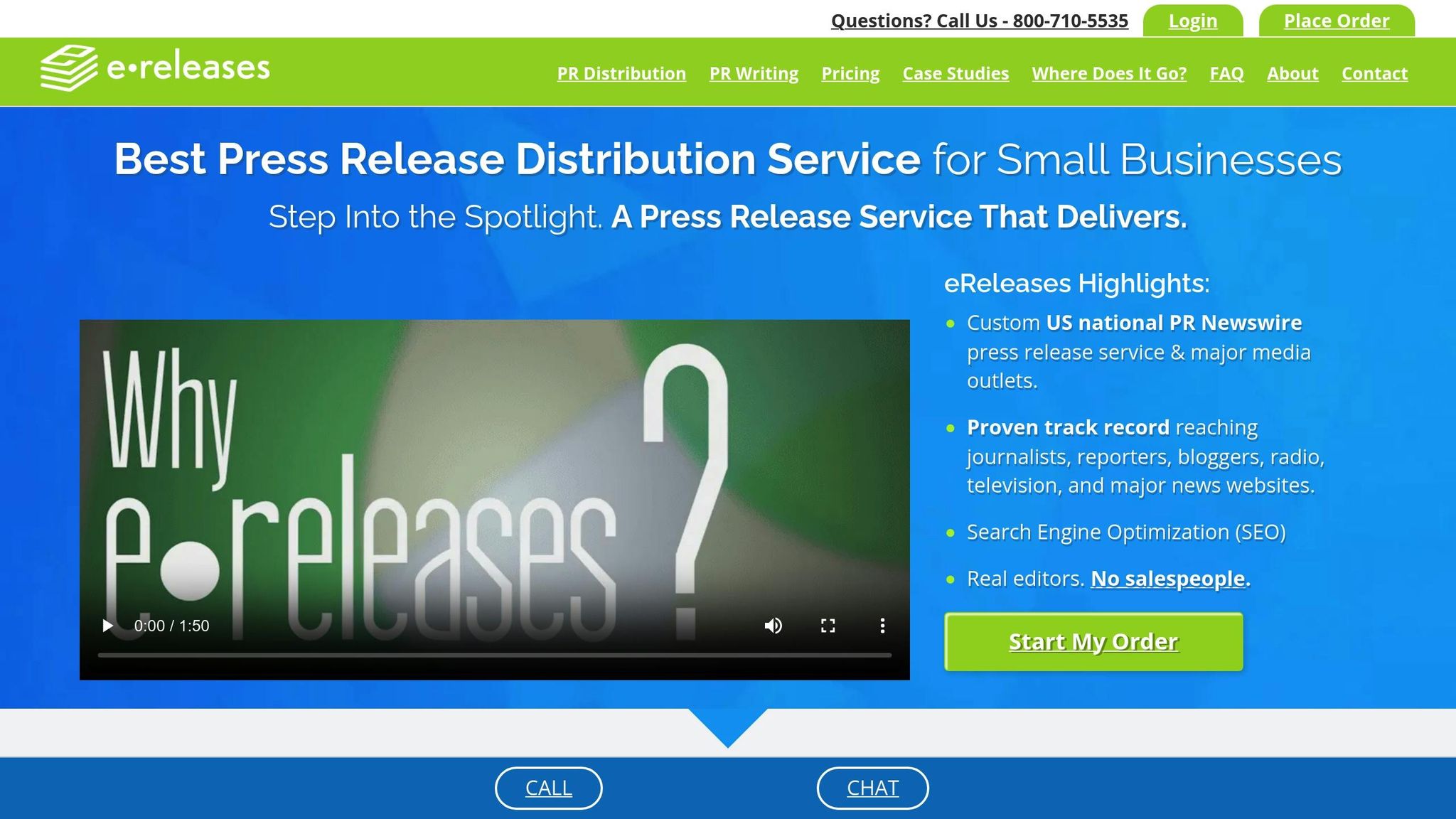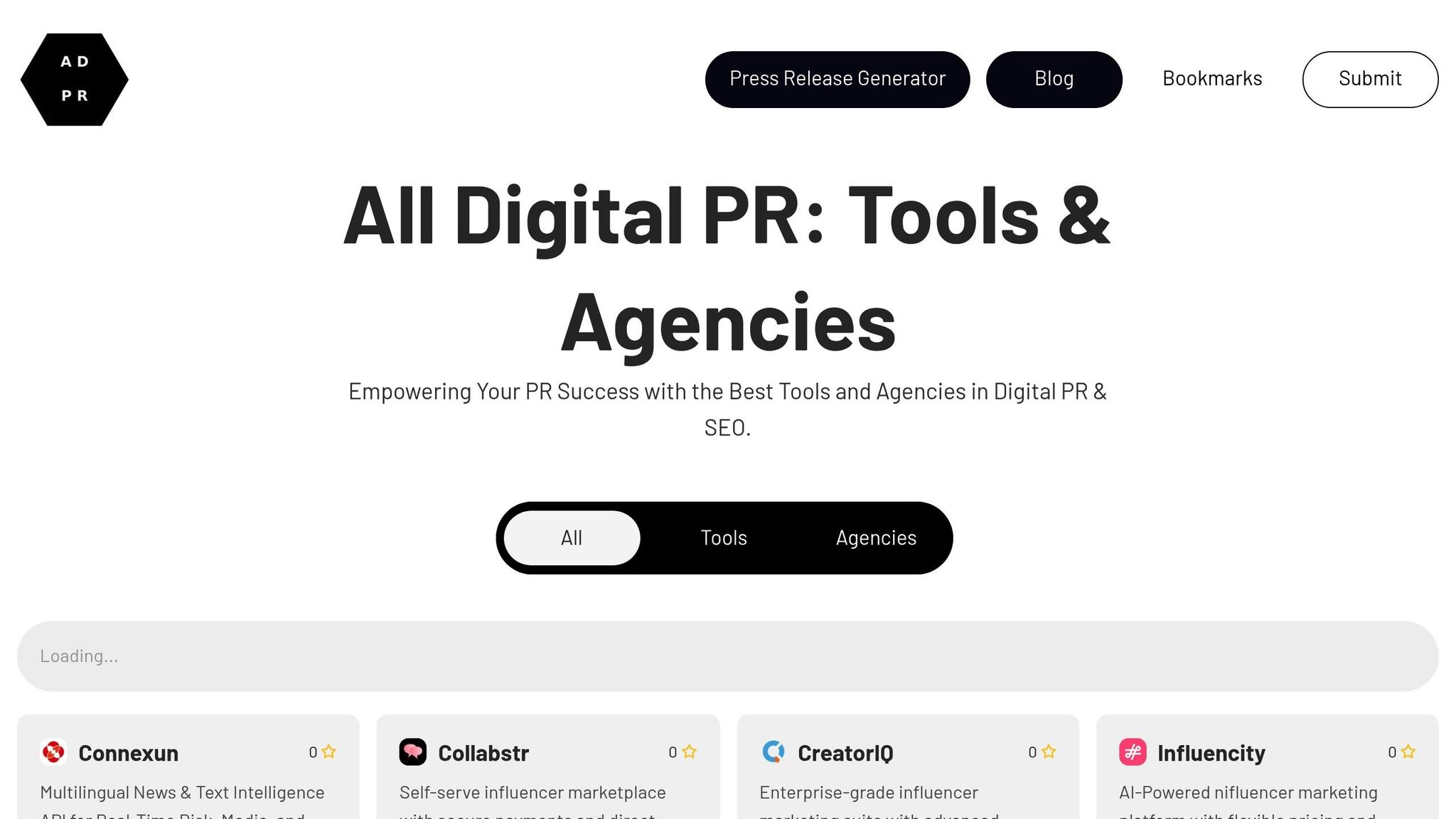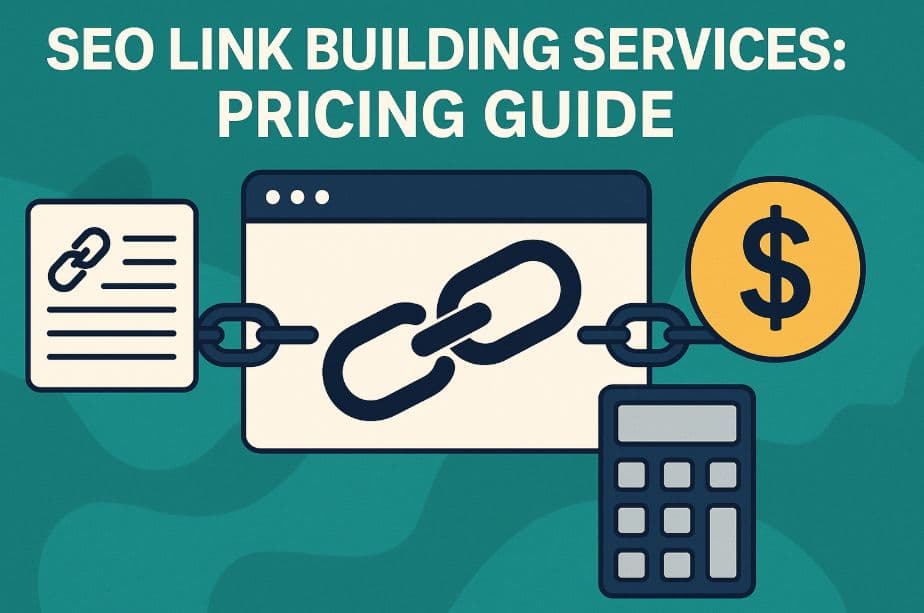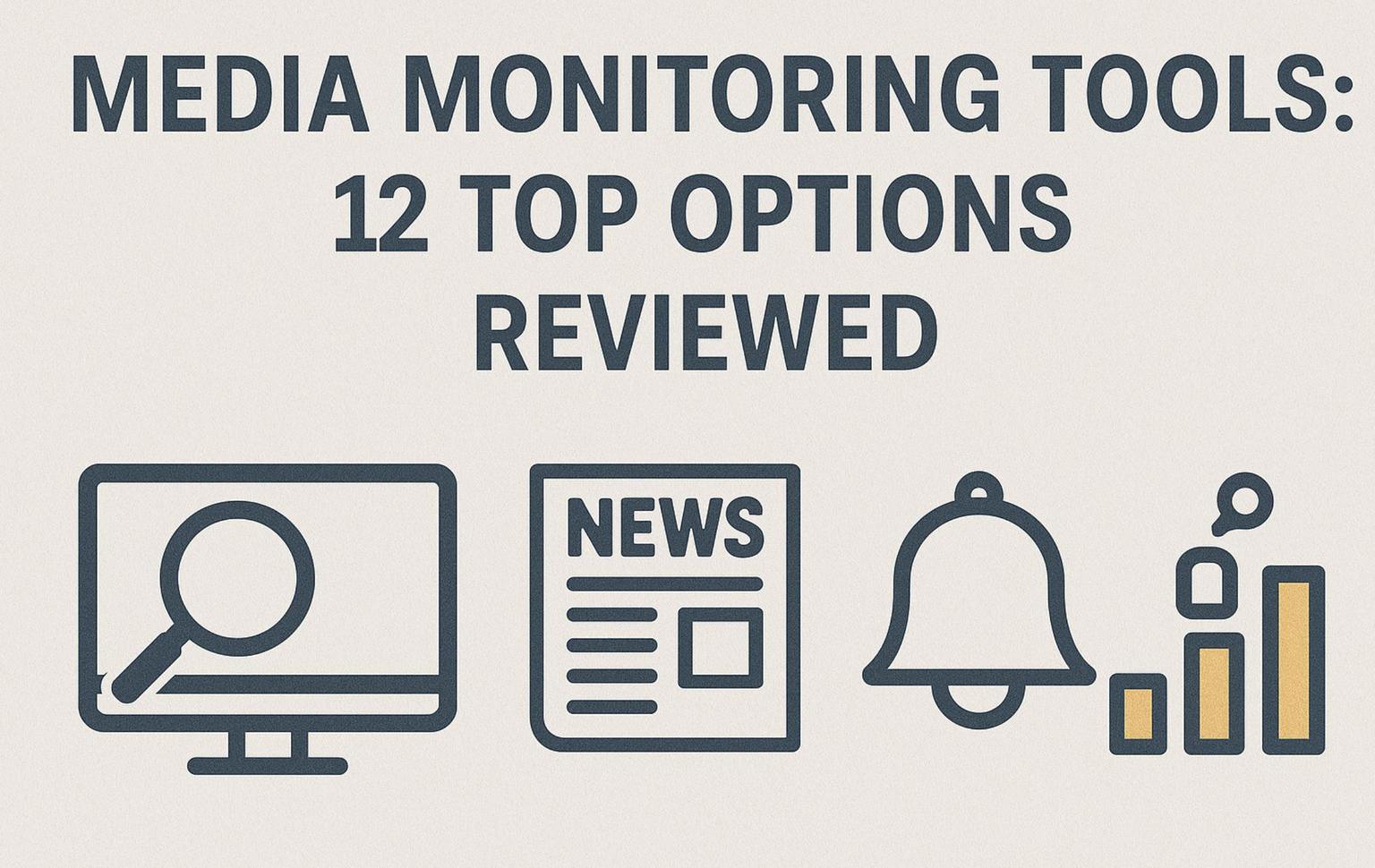AI has transformed press release writing in 2025. With three out of four PR professionals using generative AI daily, tasks like drafting, editing, and distribution now take minutes instead of hours. This shift enhances productivity, reduces costs, and improves results. Key highlights include:
- 82% of PR professionals use AI for brainstorming, 72% for drafting, and 70% for editing.
- Brands using AI report 36% higher conversion rates and 120% growth in organic traffic.
- Tools like NLP and generative AI create polished, SEO-friendly, and personalized content.
- AI analytics refine messaging by analyzing trends, audience data, and media performance.
Choosing the right tools is critical, with platforms like AllDigitalPR Directory simplifying selection. By combining AI's speed with human creativity, PR teams can craft impactful, data-driven press releases that resonate across platforms.
ChatGPT Prompts to Create AI Press Releases with eReleases Mickie Kennedy

Key AI Technologies in Press Release Writing
AI is reshaping how press releases are written and distributed, offering tools that tackle common challenges faced by PR professionals. These technologies streamline processes, improve messaging, and help create more impactful campaigns.
Natural Language Processing for Better Clarity
Natural Language Processing (NLP) plays a central role in modern press release writing. It enables AI to grasp context, tone, and semantics, resulting in content that feels natural and engaging.
For instance, 80% of journalists favor AI-driven press releases that merge data insights with compelling narratives. NLP ensures consistency in tone, formatting, and message across campaigns. Even subject line generators powered by NLP can analyze vast amounts of historical data to predict open rates with impressive accuracy.
Personalization is another advantage. AI-generated emails tailored to individual recipients receive eight times more replies than generic ones. Similarly, NLP allows press releases to be customized for specific media outlets and journalist preferences, increasing their effectiveness.
However, human oversight remains essential. Industry expert Eftychiadou highlights the growing volume of media requests, stating:
"They're getting thousands of media requests. With the efficiency AI brings, they're getting more".
To make the most of NLP, PR teams should carefully review AI outputs to ensure accuracy and alignment with brand messaging. This includes simplifying technical jargon, refining structure for readability, clarifying ambiguous points, and double-checking all facts and figures.
Next, let’s look at how generative AI is speeding up and refining press release creation.
Generative AI for Content Creation
Generative AI has revolutionized the speed and efficiency of press release creation. It can draft professional-quality releases with minimal human input, optimizing them for audience engagement. As of now, 26% of PR professionals actively use generative AI, while 42% are open to adopting it.
This technology is versatile. Nearly half of users (49%) rely on it for writing headlines, and 41% use it for body copy and proofreading. AI tools have also been shown to boost ad click-through rates by 38% and cut cost-per-click by 32%.
Generative AI adapts to unique brand voices by incorporating keywords, slogans, and stylistic preferences. It also provides real-time grammar checks, fact validation, and instant feedback, reducing errors and enabling quick turnarounds - ideal for responding to breaking news or trending topics. Additionally, it supports personalization, allowing PR teams to create multiple versions of a release tailored to different outlets, regions, or industries.
The technology is advancing rapidly. In December 2024, OpenAI launched Sora AI, a tool that turns text into video using simple prompts, making video content creation more accessible.
As The Verge puts it:
"AI writing is likely to take over as much of digital publishing and editing as readers will tolerate".
The key to success lies in blending human creativity with AI efficiency. Teams must also ensure proper training in using these tools while safeguarding data security. Now, let’s explore how AI analytics is shaping data-driven messaging.
AI Analytics for Data-Driven Messaging
AI analytics is transforming press release writing into a precise, data-driven process. By analyzing media trends, audience demographics, social sentiment, and performance metrics, these tools help refine storytelling, improve placement, and boost overall ROI.
This technology aids decision-making at every stage of a campaign. It identifies trends, profiles audiences, crafts narratives, and organizes assets. One standout feature is its ability to recommend journalists who are likely to engage with a story based on their previous coverage. Tools like AIM Fluence showcase how analytics can pinpoint top-performing topics and journalists for specific campaigns.
Despite its potential, challenges remain. While 87% of business leaders see AI as critical, only 42% fully trust its insights. Additionally, 74% of executives cite infrastructure costs, data silos, and slow data processing as barriers to adoption.
Mike Capone, CEO of Qlik, emphasizes the importance of execution:
"AI isn't a lab experiment anymore - it's the baseline. What separates leaders now is execution. That means embedding intelligence where decisions get made, and doing it with speed, trust, and scale".
To effectively use AI analytics, combine insights from tools like Google Trends, BuzzSumo, and social listening platforms with CRM data and survey results. Use this data to craft compelling stories and embed key statistics into press releases. Visual aids like infographics can clarify complex data, while performance tracking tools such as SEO analytics and sentiment analysis ensure campaigns stay on track. These strategies are part of a broader shift toward smarter, AI-enhanced PR workflows.
Top AI Tools for Press Release Writing and Distribution
AI tools are transforming how press releases are created, distributed, and analyzed. By combining natural language processing (NLP) and machine learning, these platforms help PR professionals produce engaging content, track audience engagement, and improve SEO performance.
The best tool for you will depend on your specific needs, budget, and workflow. Options range from all-in-one PR platforms to specialized tools, each offering unique features and pricing.
AI Tool Comparison
When deciding on an AI tool for press release tasks, it’s important to weigh factors like content quality, automation capabilities, ease of integration, and overall cost.
| Tool | Primary Function | Key Features | Monthly Price | Best For |
|---|---|---|---|---|
| Prowly | Complete PR platform | AI content creation, media database, distribution | $258+ | Full-service PR teams |
| ChatGPT Plus | AI writing assistant | Advanced content generation, research capabilities | $25 | Content creation and ideation |
| Jasper | Marketing content AI | Brand voice training, SEO optimization | $39+ | Brand-consistent content |
| Grammarly | Writing enhancement | Grammar checking, tone adjustment | $12+ (after 100 free prompts) | Content refinement |
| Wordtune | Content rewriting | Sentence rephrasing, clarity improvement | $6.99+ | Content optimization |
| Claude Pro | AI assistant | Coding tasks, warm conversational tone | $20 | Technical and creative tasks |
| SurferSEO | SEO optimization | Keyword research, content optimization | $49+ | Search visibility |
Sam Ward, Head of AI Research and Development at Enate, highlights the importance of usability:
"An AI tool worth its salt should be intuitive and user-friendly. Complexity should happen behind the scenes, allowing your team to integrate the tool into their existing workflows without requiring extensive training. Focus on tools with a clean interface and comprehensive, easy-to-understand documentation".
Cost considerations go beyond the monthly subscription fee. Kit Cox, Founder and CTO of Enate, advises:
"Don't just evaluate the upfront cost of the AI tool. Consider ongoing expenses, including maintenance, training, support, and any additional credits you might need - these can really rack up. Make sure that the ROI justifies the total investment".
Data shows that businesses prioritizing easy-to-use AI tools often experience a 20% higher success rate. Additionally, over 75% of marketers now use AI software regularly, with nearly half relying on it multiple times a week as of 2023. ChatGPT alone reached an impressive 200 million users by October 2024, showcasing the growing reliance on AI writing tools.
To find the right fit for your needs, test identical prompts across several platforms. This approach helps you compare response quality, accuracy, and how well each tool aligns with your brand’s voice and goals.
Using AllDigitalPR Directory for Tool Selection

Navigating the variety of AI tools available can be overwhelming, but platforms like the AllDigitalPR Directory make it easier. This resource provides a centralized way to compare AI-powered PR tools for press release writing, distribution, and more.
The directory offers detailed listings that allow businesses to evaluate tools based on features, functionality, user interfaces, customer support, and pricing. This streamlined approach saves time and ensures you don’t overlook options that might not appear in a standard search.
Key advantages of using the AllDigitalPR Directory include:
- Access to user reviews and ratings that offer real-world insights into tool performance and reliability.
- Categorization by use case, making it simple to identify tools tailored to specific needs, such as content creation or media monitoring.
- A clear view of integration options, helping you assess compatibility with your existing systems, as emphasized by Kit Cox:
"A powerful AI tool should be able to integrate smoothly with your existing systems. Check for API support and compatibility with your current software stack. The easier the integration, the quicker you'll realise the benefits".
The directory also provides pricing transparency, clarifying subscription models, one-time fees, or usage-based costs. This helps avoid unexpected expenses and ensures alignment with your budget.
Before making a final decision, take advantage of free trials or proof-of-concept tests using your own data and workflows. This hands-on testing can reveal how tools perform in practical scenarios, beyond the marketing claims.
As AI continues to evolve, using a resource like the AllDigitalPR Directory ensures you stay informed about the latest tools and trends in press release writing and distribution. This proactive approach helps businesses remain competitive by adopting solutions that align with their PR strategies.
sbb-itb-3230277
Best Practices for AI-Optimized Press Releases
Crafting AI-optimized press releases is all about balancing technical precision with engaging storytelling. As AI increasingly shapes how news is consumed, PR professionals need to ensure their content is both discoverable by AI systems and appealing to their target audience. Let’s dive into how to make your press releases stand out in this evolving landscape.
Structuring Press Releases for AI Discovery
The structure of your press release plays a huge role in whether AI systems can find, interpret, and use your content. Matthew Caiola, North America CEO of 5WPR, highlights this shift:
"If news is being consumed directly via AI summaries, we must optimize our content so that our brands appear in those summaries."
Start with the basics: place your most critical information in the first paragraph. This ensures that AI systems and readers alike grasp the core message immediately. Leverage schema markup to clearly define the content's purpose and improve its visibility in AI-generated snippets and search results. For example, FAQ schema markup can make your press release more likely to appear in AI-driven answers and summaries.
To make your press release AI-friendly, focus on:
- Writing concise, data-rich headlines.
- Using bullet points for clarity and quick scanning.
- Naming multimedia files descriptively (e.g., "brand-new-product-2025.jpg") and including alt text for images.
- Adding a brief FAQ section or bulleted highlights to summarize key points.
This thoughtful structure doesn’t just improve AI discovery - it also sets the stage for blending efficiency with creativity.
Combining AI with Human Creativity
The best press releases in today’s world merge AI’s efficiency with the depth of human storytelling. In fact, 80% of journalists favor AI-enhanced, data-driven press releases that incorporate strong narratives, leading to a 40% boost in media pickups.
AI can handle tasks like research, headline suggestions, and drafting, but it’s human creativity that adds the emotional touch and context that resonate with readers. For example, Alibaba uses AI to generate 20,000 product descriptions per second, but these are refined by humans to maintain quality and brand alignment.
Here’s how to make the most of this partnership:
- Train AI tools to reflect your brand’s voice and style.
- Always review and adjust AI-generated content to ensure it aligns with your messaging.
- Use a quality control checklist to verify facts, maintain tone, and ensure consistency.
Human-crafted quotes are another way to add authenticity. As Gill Hill, an editor and brand voice specialist, explains:
"AI can't sound human. That's why it gets tone so wrong. Tone is fundamentally the communication of emotion. And emotion is (for now) a purely human concept."
Rather than viewing AI as competition, think of it as a tool to enhance your work. Ovesh Jani of Keystroke Kopy puts it best:
"You're not competing with AI, you're completing the job with it."
Once you’ve crafted a compelling narrative, use AI insights to distribute your press release with precision.
Using AI for Targeted Distribution
AI has revolutionized press release distribution, shifting it from broad, generic outreach to highly targeted campaigns. By analyzing data, AI tools can pinpoint the best journalists, influencers, and media outlets for your specific story.
Timing is key. AI can monitor sentiment in real time, helping you choose the perfect moment to release your content. For example, Thursdays between 10 a.m. and 2 p.m. are often optimal windows for press releases.
AI can also personalize your outreach. Tailored email pitches, for instance, see a 30% higher response rate compared to generic ones. AI tools can generate these variations while optimizing for SEO and engagement.
Other ways AI can enhance distribution include:
- Identifying top influencers based on audience demographics and engagement rates.
- Creating AI-generated videos with tools like Synthesia, featuring avatars that speak multiple languages to reach diverse audiences.
- Using AI-driven chatbots to boost user engagement.
Additionally, AI can track online discussions and monitor consumer sentiment, helping you spot trends and adjust your strategy. Integrated, multi-channel approaches that leverage AI insights can lead to 40% more media coverage than single-channel efforts.
Ultimately, as one expert puts it, "Publicity is about getting the right message to the right audience at the right time". AI makes that process more efficient and precise, ensuring your press releases hit the mark every time.
Future Trends in AI Press Release Writing
The world of AI-powered press release writing is changing fast, bringing new tools and approaches that are reshaping how brands connect with their audiences.
New AI Developments for PR
Emerging advancements in AI are set to revolutionize press release creation. These include:
- Real-time personalization: Crafting releases that adapt to audience behavior in the moment.
- Channel-specific adjustments: Automatically tailoring content for platforms like LinkedIn, Twitter, and traditional media.
- AI-generated video press releases: Producing professional-quality visual content with ease.
- Predictive analytics: Using historical data to forecast which stories will resonate most.
- Voice AI for press events: Providing realistic, AI-driven responses for initial media interactions.
These advancements are more than just tools - they represent a shift in how PR professionals approach their work. The numbers tell the story: 92% of companies plan to boost their AI spending, and 47% expect AI to transform nearly a third of their operations this year. Yet, only a tiny fraction - 1% - have reached full AI maturity. As Reid Hoffman, Cofounder of LinkedIn, puts it:
"AI, like most transformative technologies, grows gradually, then arrives suddenly."
How Directories Help You Stay Competitive
With AI tools multiplying rapidly, it’s tough for PR teams to stay updated. That’s where directories like AllDigitalPR Directory come in. These platforms act as a one-stop shop for discovering and comparing AI-driven PR solutions, from content creation tools to analytics platforms and distribution services.
While directories simplify tool selection today, PR professionals also need to gear up for what’s next - like AI-generated content summaries.
Preparing for AI-Generated News Summaries
The next leap in AI for PR is the rise of AI-generated news summaries, which could change how audiences consume information. Tools like ChatGPT and Gemini are no longer just for simple searches - they’re becoming trusted advisors in decision-making. Dave Wright, Co-Founder and CEO of Pattern, highlights this shift:
"Consumers aren't just using AI tools like ChatGPT or Gemini to search, they're trusting them to decide. This new level of confidence in AI-generated recommendations is reshaping how purchase decisions are made. Brands must urgently understand how they appear in these responses and adapt their content and messaging strategies to stay competitive in this new era of AI-led commerce."
To remain relevant, press releases need to align with AI discovery methods. This means writing clear, data-rich headlines and incorporating structured data markup to make it easier for AI systems to process and summarize information. Transparency and consistent messaging are also essential, especially as AI-powered media monitoring tools become critical for spotting potential issues early.
Real-world examples underline the importance of AI-optimized strategies. In June 2025, Cigna Healthcare launched AI-powered digital tools, including a virtual assistant. Early results showed two-thirds of customers actively used the assistant, and over 80% found it helpful. Similarly, Crescendo’s CX platform added new Agentic AI features, achieving an impressive 99.8% accuracy in responses.
As Ronn Torossian, Chairman & Founder of 5WPR, notes:
"AI is not a futuristic concept in PR - it's already making waves across the industry."
Navigating this AI-driven future requires a balance: embracing cutting-edge technologies while preserving the creative and strategic elements that make PR campaigns stand out.
Conclusion: Using AI for Better PR Results
In 2025, AI has reshaped press release writing, making it faster, more precise, and tailored to specific audiences. With 82% of businesses now incorporating AI tools, companies have slashed creation time by 59% while increasing output by 77%.
AI-driven press releases perform impressively, converting 47% more effectively and improving search rankings by 28%. Remarkably, 84% of readers can't distinguish AI-generated content from human-written work.
Success in this new landscape depends on blending automation with human insight. AI is excellent for drafting, optimizing SEO, and ensuring consistency, but human creativity is essential for crafting stories that resonate emotionally and strategically. This partnership not only boosts efficiency but also keeps the messaging genuine. By cutting content costs by 42% and reducing errors, AI allows teams to shift their focus to innovative and impactful strategies.
For PR professionals looking to navigate this AI-driven era, tools like AllDigitalPR Directory offer a way to evaluate and compare AI solutions for content creation, analytics, and distribution, ensuring smart and effective investments.
FAQs
How is AI transforming press release writing in 2025?
In 2025, AI is transforming how press releases are written, taking over repetitive tasks like drafting, editing, and fine-tuning content. This shift lets PR teams dedicate their energy to crafting messages that truly connect and developing strategic narratives. By analyzing data and audience behavior, AI tools can recommend language that hits the mark and even predict which phrases are likely to resonate most, leading to press releases that are more engaging and tailored to their audience.
AI is also enhancing media monitoring and personalization, enabling PR professionals to customize pitches and time their release distribution perfectly. This boosts the likelihood of grabbing media attention and engaging the intended audience. With these advancements, writing press releases has become faster, smarter, and more impactful than ever.
What are the top AI tools PR professionals should use to improve their press release strategies in 2025?
In 2025, AI-powered tools are set to transform how PR professionals craft, refine, and share press releases. Platforms like Team-GPT, Originality.ai, Hypotenuse AI, and Notion AI simplify the entire process - from drafting to formatting - helping teams produce polished and professional content while saving valuable time.
When it comes to media outreach, AI-driven personalization tools are game-changers. They allow PR teams to create highly targeted pitches and customize content for specific audiences. These tools even enable real-time tweaks to improve engagement rates, making them a must-have for any modern PR strategy. By automating repetitive tasks, professionals can dedicate more energy to building genuine relationships and boosting visibility in today’s competitive media environment.
How can PR teams make sure AI-generated content reflects their brand's voice and messaging?
To make sure AI-generated content reflects your brand's voice and messaging, start by providing AI tools with thorough brand guidelines and examples. Regularly evaluate and tweak the content they produce to keep it aligned with your brand's identity.
Develop clear documentation that defines your brand’s tone, preferred language, and main messaging points. Establish specific rules for AI-generated content and involve your team in reviewing the outputs. This collaborative approach helps ensure the content stays true to your brand’s personality and values. Consistent oversight is essential for preserving a unified brand identity.


